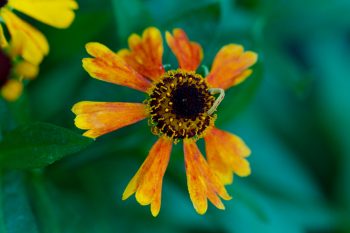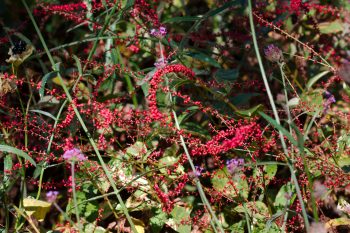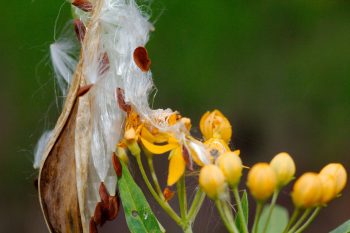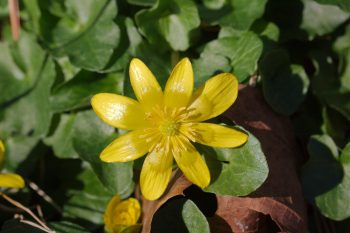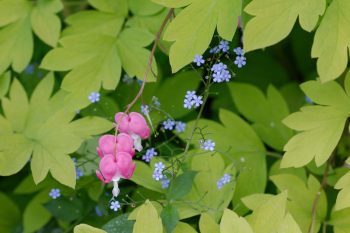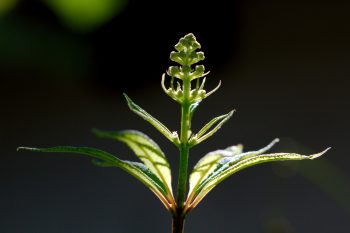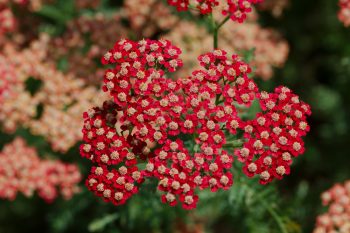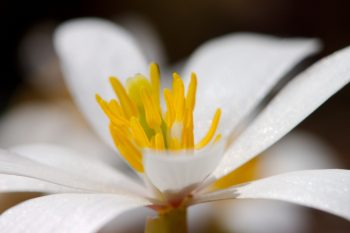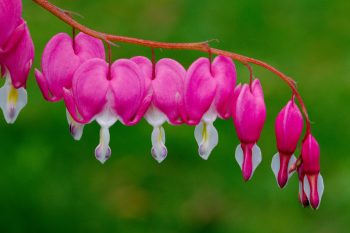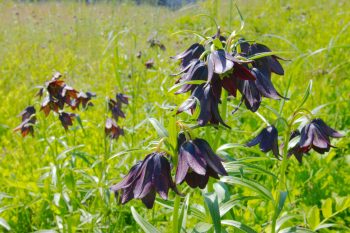This is a weed and we pull it up but it’s actually fairly attractive. It’s called white snakeroot (Ageratina altissima) and it’s a fairly common native plant in our area. It’s similar to the blue mistflower (Conoclinium coelestinum) that we have in some of our borders but quite a bit taller (it’s three or four feet tall, compared to about about a foot and a half). This one is behind some shrubs so managed to get pretty much full grown before I noticed it. It will be gone shortly but I thought I’d take some pictures, anyway.
Tagged With: Herbaceous Perennial
Ageratina altissima (White Snakeroot)
Sneezeweed (Helenium ‘Mardi Gras’)
I posted a picture of this sneezeweed (Helenium ‘Mardi Gras’) back in mid-July, when we first planted it. Almost immediately, the stems were bitten off by some animal. It was high enough that we suspected the deer but it could have been rabbits. We have a lot of rabbits. Anyway, there have been no flowers since then until just recently, when one stem was left along long enough to bloom. I may need to put some protection around this next year or at least have some deer repelling stuff near by. It’s really nice when it blooms, but if they’re going to eat it, there’s not a lot we can do.
Persicaria virginiana ‘Painter’s Palette’
I don’t really recommend growing painter’s palette (Persicaria virginiana) unless you have a lot of space and want a natural garden. It has a tendency to spread and is a bit of work to control. We have more than we need and most of the year I’m just about ready to pull it up. This is the time of year I don’t mind it quite so much. There isn’t a lot else in bloom and it provides some color in the border with it’s tiny, red flowers on wispy stalks. We have a lot of it mixed with Verbena bonariensis in the large, central bed in our front garden and the two of them together are pretty nice. The foliage is also interesting, with green alternating with a very pale green and with a reddish, V shape stripe.
Anemone hupehensis var. japonica ‘Pamina’
We bought this Japanese anemone last year and it was in a pot over the winter. I planted it this spring and for a while it looked like the rabbits were not going to let it grow or bloom. Eventually I put a fence of hardware cloth around it, which they quickly knocked over. Now it’s staked to the ground with tent pegs and isn’t going anywhere. I’m a little bothered by the background in this, where the hardware cloth gives a regular, if out-of-focus pattern. Anyway, the anemone is quite lovely and I’m pretty happy with it. Hopefully it will get well enough established that we can take down the fence.
Yellow Asclepias
This yellow Asclepias has been blooming pretty must constantly all summer. It’s really quite amazing. Others bloomed for a while and then went to seed, which is what you sort of expect, but this one just keeps putting out new buds, which open into these lovely, pure, yellow flowers. As you can see, it also has seeds. This in on our back patio and it won’t make it through the winter (unless it’s exceptionally mild, of course). It’s only really hardy to USDA Zone 9. But growing it as an annual is really worth it. Highly recommended.
Ficaria verna
Dorothy, Cathy, and I walked on the Seneca Greenway Trail this afternoon, parking where MD 28 crosses Seneca Creek and walking downstream. We only saw a few other people and it was a very pleasant walk. It’s relatively flat, with only a few ups and downs to deal with. The birds were out in force and we heard them all around, although we weren’t stopping to see them so much and didn’t really get very close to any. I did stop to take a few photos, including of this fig buttercup, also known as lesser celandine. It was formerly classified as Ranunculus ficaria but is now Ficaria verna. It’s an invasive, non-native species that grows in many of our wetlands.
Bleeding Heart and Siberian Bugloss
After going to Fehr’s Nursery in Burtonsville, we stopped for lunch as a Cuban place on the way home. We could have picked a better day for it, as it was jammed for Mothers Day and it took us over an hour to get sandwiches. We’ll probably give them another try on a less busy day, but it was a bit off-putting. We drove to Woodlawn Manor and ate our sandwiches in the shade of one of their lovely trees. Then we walked around and I took a few photos, including a couple of the bleeding heart (Lamprocapnos spectabilis) and Siberian bugloss (Brunnera macrophylla, similar to forget-me-not) growing together under an America holly (Ilex opaca). Quite pretty, don’t you think?
Platycodon grandiflorus (Balloon Flower)
A few weeks ago we went to Stadler’s with our friend Yvette to buy a few plants for her. She wanted to plant something in memory of her nephew and wanted something blue. She settled on a balloon flower (Platycodon grandiflorus), which is actually more blue to the eye than it appears here. It’s a really pretty perennial that should do well as long as it’s got the right amount of water. We bought one, too, and have it in a container outside our front door, greeting us with these big, sky blue flowers, and reminding us of Jack, as well. It’s native to the northern far-east and is quite hardy and easily grown. The only thing to watch out for is wet or poorly-drained soils (which is why growing it in a container is easier for us).
Eutrochium purpureum (Joe Pye Weed)
I stopped at the Croyden Creek Nature Center on the way home, figuring there might be something to photograph there. The swamp milkweed (Asclepias incarnata) was just starting to bloom and I took a few pictures of that with bees on it. Around the other side of the nature center there was some Joe Pye weed (Eutrochium purpureum) coming up. It’s a native, herbaceous perennial and I find it sort of humorous that garden centers actually are able to sell it, since it grows wild around here. I don’t know who Joe Pye was but I’ve seen one story that he was a Native American medicine man who used the plant for various treatments. Anyway, I was attracted to the symmetry of the leaves and the way the light was shining on them at the top of the stem.
Yarrow (Achillea millefolium)
While not a native, common yarrow (Achillea millefolium) was introduced to North America in colonial times, and has since naturalized throughout the United States. It’s considered by some to be an invasive weed, although we’ve never had a lot of luck with it surviving in our garden. This specimen is a cultivar being grown in the Master Gardener’s demonstration garden at the Agricultural History Farm Park and it’s a lovely color. It certainly makes me interested in giving it another try. There are paler versions, as well and some really nice yellows. We have plenty of yellows, though, so I think I might go for something like this.
Sanguinaria canadensis (Bloodroot)
Cathy and I were out in Poolesville today, to drop something off for someone. After that we decided to see if the bluebells have started blooming along Seneca Creek. It is definitely a bit early for the full show, but there was enough to see that we were glad we went. In addition to bluebells, which I’d say were somewhere around 5% open, there were trout lilies (Erythronium americanum), spring beauties (Claytonia virginica), and possibly my favorite spring ephemeral, bloodroot (Sanguinaria canadensis). They bloom very briefly and the flowers are very delicate, so seeing them at their peak is a real treat. Outside their short blooming period they are easily identified by their deeply-scalloped, palmate leaves, but you have to keep your eyes open, because they aren’t very flashy. The flowers are pure white, as you can see here, with beautiful, yellow stamens.
Lamprocapnos spectabilis (Bleeding Heart)
Cathy and I went to the airport this morning to pick up Dorothy and then dropped her off in Bethesda, where she had left her car. Although it’s a little early for most azaleas, we decided to visit McCrillis Gardens, since we were near by. A few azaleas and rhododendrons were in bloom and there were other things to see. Fern fiddleheads were unrolling, there was quite a bit of Solomon seal (Polygonatum species). In the middle of the yard, under a large tree, there is a huge mound of bleeding heart (Lamprocapnos spectabilis). It’s quite pretty and we probably should plant some, if for no other reason than that it would fill in some of the gap between the early bulbs and the later spring blooms.
Chocolate Lily (Fritillaria camschatcensis)
We came to Juneau expecting rain. The weather for the last few weeks has been rain for about six days out of every seven. We woke up this morning to a clear, blue sky. After breakfast, we headed out with Brian, Lisa, and the dogs to the airport flats. This is the delta of the Mendenhall River, which has basically silted up most of the channel separating Douglas Island from the mainland. There is still a small channel that’s still got water in it, even at low tide, although an annual ‘Mud Run’ crosses the channel, so it’s not terribly deep. The flats are a good place to walk the dogs and we enjoyed being out. I got a nice photo of a savannah sparrow (Passerculus sandwichensis) and we saw lots of lupine as well as many chocolate lilies (Fritillaria camschatcensis). They are pretty, in a brown sort of way, although I can’t recommend their fragrance, in particular. They are native to eastern Asia, Alaska, Yukon Territory, British Columbia and the far northwestern contiguous United States.
Crocosmia ‘Lucifer’
We’re back home from our grand Alaska adventure (or whatever you like to call it) and I thought I’d photograph the various things blooming in the yard. One of the best is this Crocosmia ‘Lucifer’. There are something like 7 species in the genus Crocosmia that come from the South African grasslands. The variety named ‘Lucifer’ is a hybrid by Alan Bloom (Crocosmia x Curtonus) which has flowers and foliage that are similar to gladiolus. As you can see, it has scarlet red, tubular, one-sided flowers borne along arching flower scapes. It’s one of our favorite summer blooms and every year I mean to do a little better at giving them support, although they only barely need it. We started with one or two plants and I’ve added a few more over time, so we have a nice clump of them in our front bed. We’re glad we got home while they were blooming. They attract hummingbirds, as well as the more common pollinators, which is an added treat.


